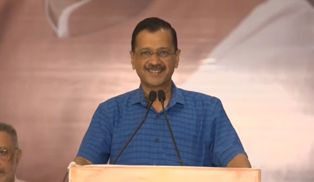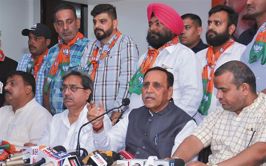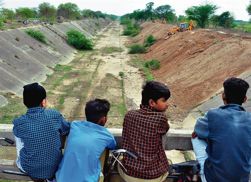
NEEDS: India, which accounts for 4 per cent of the world’s water resources, uses them for irrigation and domestic and industrial purposes. ISTOCK
SP Vasudeva
Ex-Director, Union Ministry of Water Resources
LATEST data released by the Central Water Commission paints a grim picture of the live storage in India’s reservoirs, particularly in the southern states. The reservoir levels in South India have plummeted to just 17 per cent of their capacity amid a widespread heatwave. This does not augur well for the water security of the region and the country as a whole.
India, which accounts for 4 per cent of the world’s water resources, uses them for irrigation, and domestic and industrial purposes. Surface and groundwater, as per ease of availability, are put to various uses. There is, however, a shortage of water across states, leading to crop failure, deaths, closing down of healthcare facilities and industries. India has become ‘water-stressed’, with the per capita per year water availability being 1,545 cubic metres, less than the stipulated 1,700 cubic metres. At this rate, India is projected to become ‘water-scarce’ by 2050, when the availability will be less than 1,000 cubic metres.
Various states have made significant infrastructural investments in irrigation, but a lack of regular maintenance and quality service are causing bottlenecks. Water left untreated after domestic, industrial and other uses is causing surface and groundwater pollution. Groundwater is also getting polluted through an excessive use of chemical fertilisers and pesticides. The Centre had informed the Supreme Court in 2016 that about 33 crore people in 256 districts of 10 states were affected by drought. Appropriate practices, innovative technologies and positive participation of all stakeholders are required for moving towards sustainable and efficient water use management.
India started on a positive note after Independence by utilising surface water of rivers through multipurpose projects, hydroelectric and water harvesting dams. However, over the past four decades, about 84 per cent of the total addition to irrigation areas, 80 per cent of the drinking water needs and most of the industrial use is met from groundwater. India, consequently, is the world’s largest user of groundwater, accounting for 25 per cent of the global withdrawals. As a result, the water table has been dipping at an average of 0.4 metre every year.
With water being a state subject, states/UTs need to do policy correction. The adoption of measures such as water conservation, groundwater recharge, conjunctive use of surface and groundwater, economic use of water through appropriate pricing and application of technologies and increasing water use efficiency through recycling can improve the situation. The implementation of measures like crop rotation and diversification, increase in drip and sprinkler irrigation and creating awareness can further bring water use efficiency.
The National Water Mission was launched in 2011 in order to conserve water, reduce wastage and ensure equitable distribution across and within states, besides introducing a framework for optimising water use efficiency by 20 per cent. Many interventions and schemes have been introduced under this mission. The ‘Per Drop More Crop’ scheme, introduced in 2015, promotes water use efficiency through micro irrigation, especially drip and sprinkler irrigation. However, only about 10 per cent of the net sown area has been covered under micro irrigation. The Sahi Fasal campaign — an awareness generation programme for educating farmers to adopt crops that are economically remunerative, environmental friendly and improve water use efficiency — has been launched. It is moving at a slow pace, but would bring dividends if implemented in right earnest. The Jal Shakti Abhiyan is being implemented since 2019, with multi-stakeholder participation, especially of women, to optimise harvesting of rainwater and integrating it with afforestation. Desilting of water bodies and revitalising of abandoned borewells have also been initiated. Progress under this initiative is dismal, with watershed development works progressing at a sluggish pace and intensive afforestation yet to begin.
Atal Bhujal Yojana was started in 2020 to deal with overexploited and water-stressed areas of seven states. The Union Ministry of Jal Shakti has circulated a Model Bill among all states/UTs to curb overexploitation and depletion of groundwater. Several states have enacted legislation, but implementation has been effected only in a few. Industries extracting groundwater in excess of 100 cubic metres/day are now required to get an annual water audit done and reduce water use by 20 per cent over the next three years. This is a step in the right direction
The Jal Jeevan Mission is on course to provide piped drinking water with a functional tap connection to each household in the country by the year-end. About 76 per cent of the rural households have been covered and those remaining and in urban areas are being targeted. Participatory irrigation management has brought efficiency and reduced the gap between the created and utilised irrigation potential. These actions are helping in moving towards demand-driven supply of drinking and irrigation water that would make consumers responsible for making timely payments that can be utilised for proper operation and maintenance of infrastructure.
The NITI Aayog has developed the Composite Water Management Index (CWMI), covering drinking water, irrigation, sanitation, source augmentation and restoration of water bodies and groundwater, watershed development, sustainable on-farm water use practices to access and further improve water management performance. These performance indicators, integrated with improved policy and governance, are providing useful information to states/UTs and Union ministries/departments to formulate and implement sustainable strategies and practices for efficient and sustainable water management.
There is a need for a paradigm shift in taking forward strategies and regulations and integrating these through the CWMI. However, the absence of holistic implementation and regular and participatory monitoring at the block, district, state and national levels is hindering the pursuit of sustainable supply and improved water use efficiency.
Join Whatsapp Channel of The Tribune for latest updates.




























